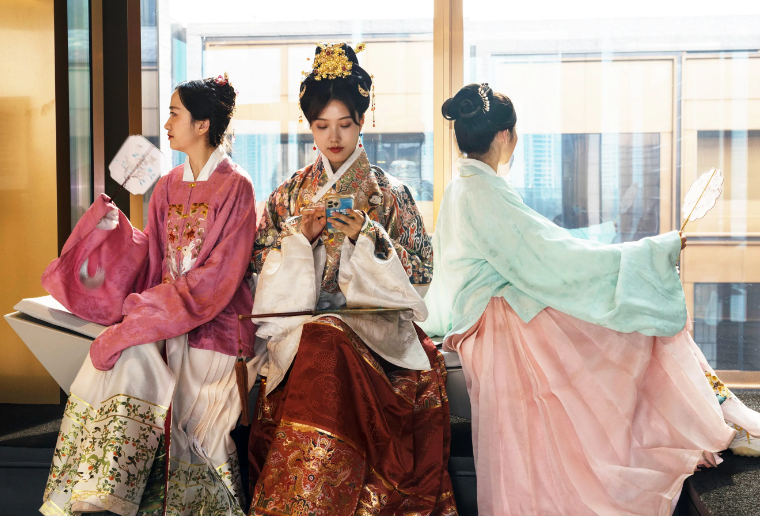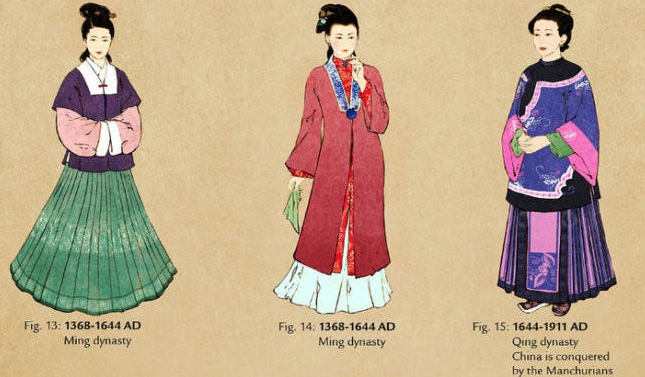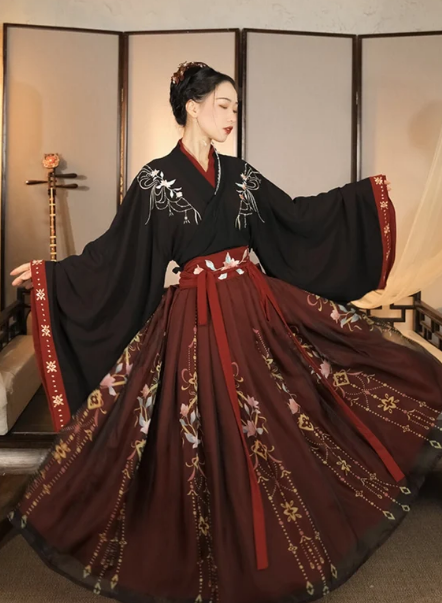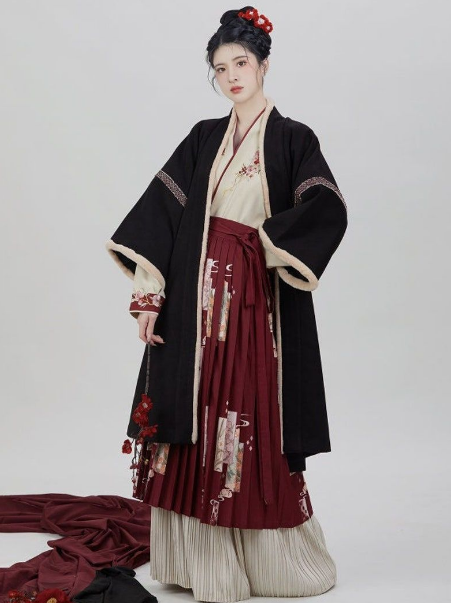Introduction to Hanfu
Definition of Hanfu
Hanfu, known as “汉服” in Chinese, refers to the traditional clothing worn by the Han ethnic group in China. It encompasses a wide range of styles, reflecting the diverse fashion trends that have evolved over thousands of years.
Brief Overview of its Historical Roots
The history of Hanfu can be traced back to the Xia and Shang Dynasties (c. 21st-11th centuries BCE), making it one of the world’s oldest surviving clothing traditions. It has witnessed continuous evolution through various dynasties, each leaving its unique imprint on the attire.

Cultural Significance in Chinese History
Hanfu holds profound cultural significance in the history of China. It serves as a symbol of national identity, reflecting the values, aesthetics, and social hierarchy of different historical periods.
- Social Hierarchy: Throughout history, Hanfu has been a visible marker of social status and class. The materials, designs, and accessories used in Hanfu varied based on one’s position in society. For example, during the Tang Dynasty, high-ranking officials wore clothing adorned with intricate embroidery and luxurious silk, emphasizing their authority and wealth.
- Ceremonial Importance: Hanfu played a pivotal role in traditional Chinese ceremonies and rituals. Weddings, coming-of-age ceremonies, and ancestral worship often involved specific Hanfu attire. These garments were chosen to signify purity, respect, and the importance of the occasion.
- Cultural Continuity: Despite changes in fashion over millennia, Hanfu has remained a symbol of cultural continuity and heritage. It embodies the timeless connection between modern Chinese people and their ancestors, carrying forward the essence of ancient traditions.
- Aesthetics and Beauty: Hanfu is celebrated for its aesthetic appeal, with each dynasty contributing distinct styles and artistic elements. From the flowing, elegant robes of the Tang Dynasty to the graceful simplicity of the Song Dynasty, Hanfu reflects the evolving tastes and aesthetics of Chinese culture.
- Influence on Modern China: While modern clothing trends in China have shifted towards Western-style clothing, Hanfu continues to hold a special place in Chinese culture. It is often worn on special occasions, festivals, and in cultural performances, showcasing its enduring influence and importance.
The rich history and cultural significance of Hanfu make it an integral part of China’s heritage, reflecting the country’s diverse and evolving identity.
For more detailed information, you can explore the Wikipedia page on Hanfu to delve deeper into its historical and cultural significance.
Historical Evolution
Early Origins in Ancient China
The roots of Hanfu can be traced back to the Xia and Shang Dynasties (c. 21st-11th centuries BCE), where clothing primarily consisted of animal hides and woven plant fibers. Hanfu during this era was functional, emphasizing durability and protection against the elements.
Influence of Different Dynasties on Hanfu Design
Zhou Dynasty (c. 1046 BCE – 256 BCE)
During the Zhou Dynasty, significant innovations in textile production emerged. The introduction of the cross-collar robe and wide sleeves marked a departure from previous clothing styles. These changes provided greater mobility and comfort while emphasizing the hierarchical structure of society.
Tang Dynasty (618 – 907 CE)
The Tang Dynasty saw a zenith of Hanfu fashion. Silk, the dominant fabric, became more affordable and accessible, leading to greater variation in clothing styles. Long robes, wide sleeves, and intricate embroidery showcased the opulence of the period.
Key Transitions and Changes Over the Centuries
Song Dynasty (960 – 1279 CE)
The Song Dynasty embraced simplicity and practicality in Hanfu design. Attire became more functional, reflecting Confucian ideals of modesty and frugality. Loose-fitting clothing made daily tasks more manageable.
Ming and Qing Dynasties (1368 – 1912 CE)
The Ming Dynasty marked a revival of traditional Hanfu styles. Rich patterns, vibrant colors, and ornate accessories exemplified the period’s prosperity. The Qing Dynasty introduced elements like the “qipao” for women, emphasizing form-fitting attire.
Modern Era and Decline
In the early 20th century, Western clothing began to influence Chinese fashion. The shift towards Western attire gained momentum in urban areas, leading to a decline in Hanfu’s everyday use.
Contemporary Revival
In recent decades, there has been a resurgence of interest in Hanfu. Enthusiasts are rediscovering and reviving traditional designs, from daily wear to elaborate ceremonial robes. This revival is a testament to the enduring appeal and cultural significance of Hanfu.
Throughout its evolution, Hanfu’s materials, styles, and societal roles have reflected the changing dynamics of Chinese history, from ancient traditions to the modern era.
For more in-depth historical information, you can explore the Wikipedia page on Hanfu to gain a comprehensive understanding of its development and transitions over time.
Key Characteristics
Traditional Designs
- Cross-Collar Robe: The cross-collar robe is a hallmark of Hanfu. It features a distinct diagonal collar that crosses from the right side to the left, symbolizing harmony and balance.
- Wide Sleeves: Hanfu is known for its wide, flowing sleeves. These sleeves not only add elegance but also allow for greater freedom of movement.
Fabric Materials
- Silk: Silk is the most renowned fabric used in Hanfu. Its luxurious texture and natural sheen make it highly prized. Silk was historically associated with wealth and prestige.
- Cotton and Linen: In addition to silk, cotton and linen were also common materials, offering comfort and breathability, especially in hot and humid climates.
Color Symbolism and Patterns
- Color Symbolism: Colors in Hanfu are not arbitrary; they convey symbolism. For example, red symbolizes joy and celebration, while black represents solemnity and mourning.
- Patterns: Elaborate patterns, often with intricate embroidery or motifs inspired by nature, are a hallmark of Hanfu. These patterns vary in complexity and can be specific to the wearer’s gender, age, and social status.
Role of Accessories and Hairstyles
- Accessories: Accessories played a crucial role in Hanfu attire. For women, hairpins, jade ornaments, and silk ribbons adorned hairstyles. Men often wore jade belt buckles and tassels as status symbols.
- Hairstyles: Hairstyles were carefully chosen to complement Hanfu attire. For example, during the Tang Dynasty, women often wore their hair in elaborate styles with intricate hairpieces.
These key illustrate the attention to detail and symbolism that are integral to Hanfu. The choice of materials, designs, and colors was not only a matter of aesthetics but also conveyed cultural and social messages, reflecting the values and ideals of the time.
For more information on Hanfu’s , you can explore the Wikipedia page on Hanfu for additional details and historical context.
Types and Styles
Everyday Hanfu for Men and Women
- Everyday Wear: Everyday Hanfu is designed for comfortable, practical use. Men’s everyday attire often consists of a cross-collar robe paired with loose trousers, while women wear layered dresses or robes with wide sleeves. These designs prioritize ease of movement and are typically made from more affordable materials like cotton or linen to keep costs lower.
- Simplified Designs: Everyday Hanfu tends to have simpler designs and fewer ornate patterns compared to formal or ceremonial styles. These styles prioritize functionality and comfort over elaborate aesthetics.
- Regional Variations: Different regions of China have their own variations of everyday Hanfu, influenced by local climates and cultural traditions. For example, in southern China, lightweight and breathable materials are favored to combat the heat, while in the north, heavier fabrics are used to keep warm in colder winters.
Formal and Ceremonial Hanfu
- Formal Attire: Formal Hanfu is characterized by its intricate designs, luxurious fabrics, and elaborate patterns. These garments are reserved for special occasions such as weddings, official ceremonies, and important gatherings. Formal Hanfu often includes multiple layers, with the innermost layer being a plain robe and the outer layers featuring rich embroidery and decorative elements.
- Ceremonial Significance: Ceremonial Hanfu is chosen with care to reflect the solemnity and importance of the event. Specific colors and patterns may be selected to convey cultural symbolism and values. For instance, red is commonly worn at weddings to symbolize happiness and luck.
- Gender Distinctions: Traditional Hanfu distinguishes between men’s and women’s formal attire. Men typically wear long robes with wide sleeves, while women’s attire may include elaborate dresses with ornate headpieces and accessories.
Regional Variations and Distinctive Styles
- Regional Influences: Hanfu styles can vary significantly by region. For example, the “Hanfu” from the Han people in the central plains of China differs from the styles of ethnic minorities in regions like Tibet and Xinjiang. These variations reflect diverse cultural traditions and influences.
- Distinctive Styles: Some Hanfu styles are associated with specific historical periods or dynasties. For instance, the “Tang-style” Hanfu is known for its vibrant colors and flowing robes, while the “Ming-style” Hanfu emphasizes ornate patterns and rich fabrics.
- Incorporation of Ethnic Elements: In regions with ethnic diversity, Hanfu may incorporate elements from other cultures and ethnic groups, resulting in unique hybrid styles that blend traditional Han Chinese attire with local influences.
The diversity of Hanfu types and styles showcases the adaptability and versatility of this traditional clothing, serving both everyday needs and special occasions while preserving cultural heritage. For more details on Hanfu styles and regional variations, you can refer to the Wikipedia page on Hanfu for a comprehensive overview.
Cultural Significance
Role of Hanfu in Traditional Ceremonies (e.g., Weddings, Festivals)
- Weddings: Hanfu plays a central role in Chinese weddings, embodying cultural values and traditions. Brides and grooms often wear elaborate and auspicious Hanfu attire. Red is the dominant color, symbolizing joy and happiness, and gold embroidery is used to enhance the luxuriousness of the garments. The specific designs and accessories worn vary by region, reflecting local customs and beliefs.
- Festivals: During traditional Chinese festivals like the Lunar New Year or Mid-Autumn Festival, wearing Hanfu is a way to connect with cultural heritage. Families gather in their finest Hanfu attire to celebrate, fostering a sense of unity and tradition. Festive Hanfu often features bright colors and auspicious symbols to bring good fortune.
Reflection of Social Status and Hierarchy
- Materials and Embellishments: Historically, the choice of materials and embellishments in Hanfu conveyed one’s social status and wealth. High-ranking officials and nobility wore clothing made of silk with intricate embroidery and costly accessories. Commoners, on the other hand, often dressed in simpler cotton or linen garments.
- Rank and Position: Hanfu’s design and accessories could also denote one’s rank and position in the imperial court. The color, patterns, and the presence of specific symbols were regulated to maintain social hierarchy.
Connection to Confucian Values and Etiquette
- Confucian Ideals: Hanfu attire, closely linked to Confucianism, emphasizes principles of respect, filial piety, and humility. The modest and graceful appearance of Hanfu reflects these values, with clothing that covers the body modestly.
- Etiquette: Hanfu is associated with a specific set of etiquettes and rituals. For example, the way one bows, gestures, or handles accessories is governed by traditional norms. The proper wearing of Hanfu demonstrates respect for tradition and etiquette, contributing to a harmonious society.
- Cultural Continuity: Hanfu’s adherence to Confucian values has allowed it to endure through centuries, providing a tangible link between past and present Chinese culture. Wearing Hanfu represents a commitment to the preservation of these values.
The cultural significance of Hanfu extends beyond fashion; it serves as a tangible expression of Chinese heritage, values, and social customs. The attire’s role in ceremonies, reflection of social hierarchy, and connection to Confucian ideals contribute to its enduring importance in Chinese culture. For more information on Hanfu’s cultural significance, you can explore the Wikipedia page on Hanfu to gain additional insights and historical context.
Contemporary Revival
Recent Resurgence of Interest in Hanfu
- Youth-Led Movement: In the 21st century, there has been a remarkable resurgence of interest in Hanfu, primarily led by China’s younger generation. Online communities, social media, and fashion shows have played a pivotal role in popularizing Hanfu, with enthusiasts sharing their passion for traditional clothing.
- Influence of Media: Television dramas and historical movies featuring characters in Hanfu have contributed significantly to the revival. These shows showcase the beauty and elegance of Hanfu, inspiring viewers to embrace their cultural heritage.
- Global Reach: The revival of Hanfu extends beyond China’s borders, with enthusiasts and communities forming in various countries. This global interest reflects the universal appeal of Hanfu’s aesthetics and cultural significance.
Influence on Modern Fashion and Identity
- Blending Traditional and Modern: Contemporary Hanfu enthusiasts often blend traditional styles with modern elements. This fusion has given rise to innovative designs, making Hanfu adaptable for everyday wear, not just special occasions.
- Cultural Identity: For many, wearing Hanfu is a way to connect with their cultural identity and heritage. It provides a sense of belonging and pride in Chinese traditions, particularly among the diaspora.
- Influence on Fashion: Hanfu’s influence on modern fashion trends is evident as designers actively integrate elements like wide sleeves, cross-collars, and traditional patterns into their collections.This cross-pollination enriches the global fashion landscape.
Efforts to Preserve and Promote Traditional Hanfu in the 21st Century
- Revivalist Workshops: Traditional Hanfu workshops have emerged, where skilled artisans teach enthusiasts the art of crafting and sewing Hanfu. These workshops focus on preserving traditional craftsmanship and techniques.
- Cultural Festivals: Events and cultural festivals dedicated to Hanfu have gained popularity. These gatherings provide a platform for enthusiasts to showcase their creativity and passion for Hanfu, fostering a sense of community.
- Online Platforms: Websites, forums, and social media groups dedicated to Hanfu serve as hubs for sharing knowledge, resources, and style inspiration. These platforms facilitate the exchange of ideas and support the ongoing revival.
- Challenges and Controversies: The Hanfu revival has faced challenges, including debates over authenticity, cultural appropriation, and commercialization. Balancing preservation with modernization remains a topic of discussion within the community.
The ongoing contemporary revival of Hanfu represents a vibrant and dynamic cultural movement, one that passionately celebrates tradition while skillfully adapting to the demands of the modern world. It underscores the enduring appeal and relevance of this ancient clothing tradition in the 21st century.For a deeper exploration of this topic, you can visit the Wikipedia page on Hanfu to acquire valuable insights and a broader historical context.











